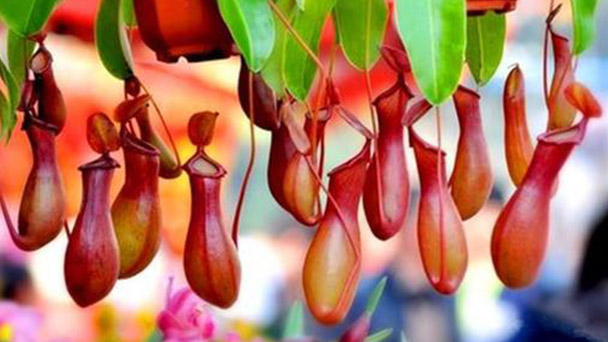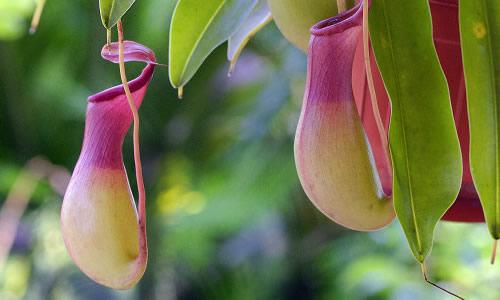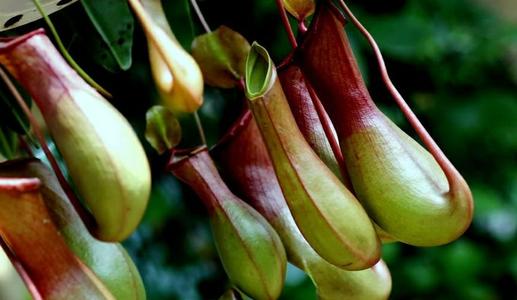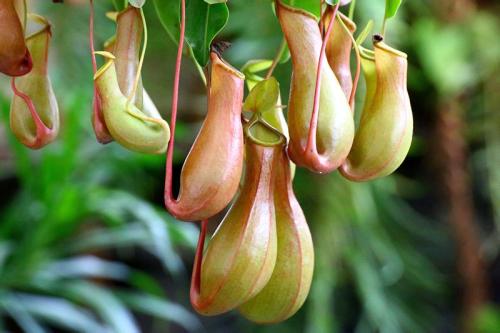Nepenthes Rajah profile
Written by Maggie
Nov 23 2020

Nepenthes Rajah has a unique nutrient-absorbing organ called a worm cage, which is cylindrical in shape with a slightly enlarged lower half and a lid on the opening.
Nepenthes Rajah is a member of the insectivorous plant family because of its poor soil in its native land and because it feeds on small animals such as insects.
Nepenthes Rajah picture

Nepenthes Rajah morphological characteristics
Nepenthes Rajah has a woody or semi-woody stem, more than 3 metres in height. Leaves are generally long oval, climbing trees or along the ground.The leaves are generally long elliptic, with a complex structure, petiole, body and tendril, and a cage at the end for easy climbing. A bottle-shaped or funnel-shaped trap with a lid forms at the end of the caged vine. Pitcher plants do not bloom until many years after growth. The flowers are generally racemes, a few panicles, dioecious, flowers are small and bland, light taste in the daytime, slightly fragrant; At night, it smells strong and stinks.They are not as ornamental as a trap. Fruit is capsule, when ripe dehiscent disperses seed.
Nepenthes Rajah growth habit
Most nepenthes rajah lives in an environment with high humidity and temperature and bright scattered light. The edge or open space of a forest or shrub. A few species, such as N. ampullaria, prefer to grow in dense, dark forests.
Nepenthes Rajah grows in an acidic and low nutrient soil, usually peat, white sand, sandstone or volcanic soil. However, there are some exceptions, such as N. rajah can grow healthily in soil with high metal content, and N. Albomarginata can grow near the high tide line of the beach. Part of Nepenthes Rajah will also become a pteridophyte and grow on the rock walls. Meanwhile, n. Inermis, for example, could even be attached to trees as epiphytes without touching the soil.

Distribution scope of Nepenthes Rajah
Nepenthes Rajah mainly distributes in southeast Asia area, of which the Borneo (also called kalimantan) and the island of Sumatra, Indonesia's island) is the most abundant, have their own distribution about 40 kinds, followed by about 30 kinds of the Philippine islands, has more than 10 kinds of the Malay peninsula, New Guinea and nearly 20 kinds of sulawesi, another African Madagascar endemic to east coast distribution two (Mr Marceau ara peninsula Nepenthes and Madagascar Nepenthes), endemic to the seychelles a (" will the pitcher),Thes Rajah is a thes variety found in Sri Lanka and North-East India, and new Caledonia is about three thes Rajah thes and RON Nepenthes, among other thes species in northern Australia. Nepenthes Mirabilis is also found in southern China, in Guangdong, Guangxi, Hainan and Taiwan. Nepenthes Rajah is the most widely distributed Nepenthes Rajah, extending from southern China through southeast Asia to northern Australia.
Nepenthes Rajah's method of reproduction
Nepenthes Rajah's includes both sexual and asexual reproduction. Nepenthes Rajah is commonly propagated by cutting, layering and sowing.
1. Nepenthes Rajah asexual propagation: cutting and aerial layering.
2. Nepenthes Rajah sexual reproduction: Sow seeds.

The purpose of Nepenthes Rajah
1. Nepenthes Rajah can be used for medicinal purposes: The original plant of Nepenthes Rajah pot in Chinese medicinal materials is N. mirabilis of the genus Nepenthes Rajah.Function: Clear lung moisten dryness, line of water, detoxification, dry cough, pertussis, jaundice, stomachache, dysentery, edema, abscess, insect bite.
2. For ornamental purposes: The main purpose of planting Nepenthes Rajah was for ornamental purposes, and the focus of the ornamental purpose was her insect trap, the cage, which was a very delicate and wonderful insect-catching tool with bright colors and strange shapes. Different varieties of Nepenthes and cages of different shapes were of high ornamental value.
Latest Updated
- Benefits of Bugleweed - 7 Science-backed Health Benefits
- Bugleweed Dangers & Side Effects - Is It Poisonous?
- How to Plant Evergreen Trees - What You Should Know
- When to Plant Evergreens - Grow Guide for Evergreen Trees
- 12 Wonderful Evergreen Shrubs for Your Garden
- 12 Popular Evergreen Plants with Pictures for Beginners
- When And How To Prune A Lilac Bush Like a Pro
- How to Grow & Care for Lilac Vine (Hardenbergia Violacea)
- Japanese Lilac Tree (Syringa Reticulata) Care & Propagation Guide
- Shumard Oak Pros and Cons - What to Know
Popular Articles
- Winter maintenance of Antirrhinum Majus
- How to Grow Terminalia Mantaly Tree
- How to Grow and Care for Crossostephium Chinense
- How to grow Antirrhinum Majus in spring
- Peristeria Elata (Dove Orchid) Profile: Info & Care Guide
- Underwatered Snake Plant (Sansevieria Trifasciata) - Signs And How To Fix
- How to Care for Brazilian Jasmine Plant (Mandevilla Sanderi)
- How to Grow & Care for Graptopetalum Purple Delight in Summer
- Rosa Chinensis (China Rose): Plant Growing & Care Tips
- How to Care for Baby Sun Rose (Aptenia Cordifolia)